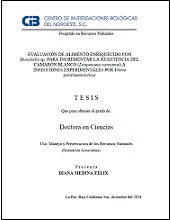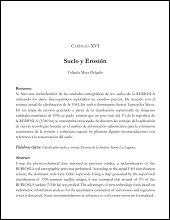Evaluación de alimento enriquecido con Dunaliell a sp. para incrementar la resistencia del camarón blanco (Litopenaeus vannamei) a infecciones experimentales por Vibrio parahaemolyticus
Resumen
"Las bacterias del género Vibrio, se encuentran normalmente en los cultivos del camarón blanco del Pacifico, Litopenaeus vannamei, formando parte del medio natural. Los vibrios son patógenos oportunistas que proliferan de forma negativa en los cultivos cuando el sistema inmune del camarón se encuentra comprometido. En 2013, se presentaron en México pérdidas significativas en los cultivos por la presencia del síndrome de muerte temprana, ocasionado por Vibrio parahaemolyticus, haciendo difícil la recuperación para la agroindustria camaronícola. La microalga Dunaliella sp. es de importancia económica por la generación de compuestos bioactivos, entre ellos el -caroteno, con función antioxidante. El objetivo de este trabajo fue evaluar la adición de harina de Dunaliella sp. al alimento de L. vannamei con el fin de reducir la mortalidad durante una infección con V. parahaemolyticus. Dunaliella sp. se cultivó en medio f/8 con una deficiencia en nitrógeno por un sistema de cultivo estático escalonado, posteriormente se liofilizó para la elaboración de las dietas. Se realizaron tres bioensayos, en el primer bioensayo se evaluaron las dosis de 1.5, 2, 2.5 y 3% de Dunaliella sp. en el alimento de L vannamei con un peso inicial de 2.6 g; después de 20 días de alimentación se infectó con V. parahaemolyticus (1x106 UFC/mL). La dieta con el 3% Dunaliella sp. presentó la mayor supervivencia (30%), debido a la alta mortalidad, los niveles de glucosa, colesterol y triglicéridos, así como propenoloxidasa y fenoloxidasa no fueron indicadores del estado de salud de los organismos. En el segundo bioensayo, se evaluó la frecuencia de adición de Dunaliella sp. en el alimento, y debido a las altas mortalidades registradas en el primer bioensayo, se evaluaron dietas con el 1.5, 2 y 3% de Dunaliella sp. a tres frecuencias de administración: diaria, cada tres y siete días en organismos de 3.1 g. Se alimentó por 20 días, previo a la infección con V. parahaemolyticus (1x106 UFC/mL). Las dietas con 2% Dunaliella sp. suministrada cada tres y siete días presentaron mayor supervivencia después de la infección con V. parahaemolyticus..." "Bacteria of the genus Vibrio are normally found in production of the Pacific white shrimp, Litopenaeus vannamei cultures, a natural part of the environment since they are opportunistic pathogens, they proliferate negatively when the immune system of organisms is compromised. In the year 2013, there were significant shrimp crop losses in Mexico, due to the presence of early mortality syndrome caused by Vibrio parahaemolitycus, making it very difficult for the shrimp industry to recover. The microalgae Dunaliella sp. has economic importance for the production of bioactive compounds, including -carotene, which has an antioxidant function. The aim of this work was to evaluate the addition of Dunaliella sp. flour in the feed of L. vannamei in order to reduce mortality during a V. parahaemolyticus infection. Dunaliella sp. was cultivated in f/8 medium with a deficiency in nitrogen levels in a staggered static culture system, then it was lyophilized for the preparation of diets. Three bioassays were carried out, in the first bioassay the doses of 1.5, 2, 2.5 and 3% of Dunaliella sp. were tested in the L. vannamei food with an initial weight of 2.6 g; after 20 days of feeding, organisms were infected with V. parahaemolyticus (1x106 CFU/mL). Diet with 3% Dunaliella sp. presented the highest survival (30%). Due to the high mortality, levels of glucose, cholesterol, and triglycerides, as well as prophenoloxidase and phenoloxidase were not good indicators of the physiologic and immune state of the organisms. In the second bioassay, it was sought to evaluate the frequency of administration of Dunaliella sp. in food, and due to the high mortalities recorded in the first bioassay, the diets were tested with 1.5, 2 and 3% of Dunaliella sp. with three administration frequencies: daily, every three and seven days in organisms with an initial weight of 3.1 g. Diets were administered 20 days prior to infection with V. parahaemolyticus (1x106 CFU/mL). Shrimp fed the 2% Dunaliella sp. diet every three and seven days showed increased survival after infection with V. parahaemolyticus..."
Colecciones
Ítems relacionados
Mostrando ítems relacionados por Título, autor o materia.
-
PROMOCIÓN DEL PERIFITON PARA EL CULTIVO DE CAMARÓN BLANCO: HACIA UNA ACUICULTURA ECOLÓGICA
DOMENICO VOLTOLINA LOBINA; JUAN MANUEL AUDELO NARANJO; MARIA DEL ROSARIO PACHECO MARGES -
Suelo y Erosión
YOLANDA LOURDES MAYA DELGADO


